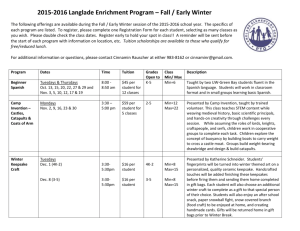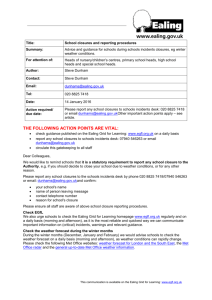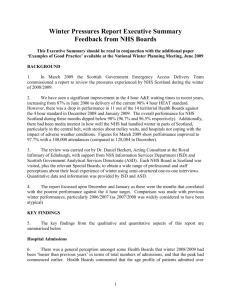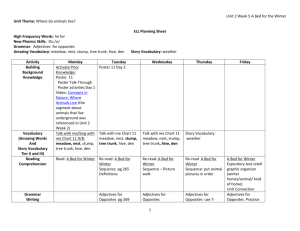item-08-winter-planning-update
advertisement
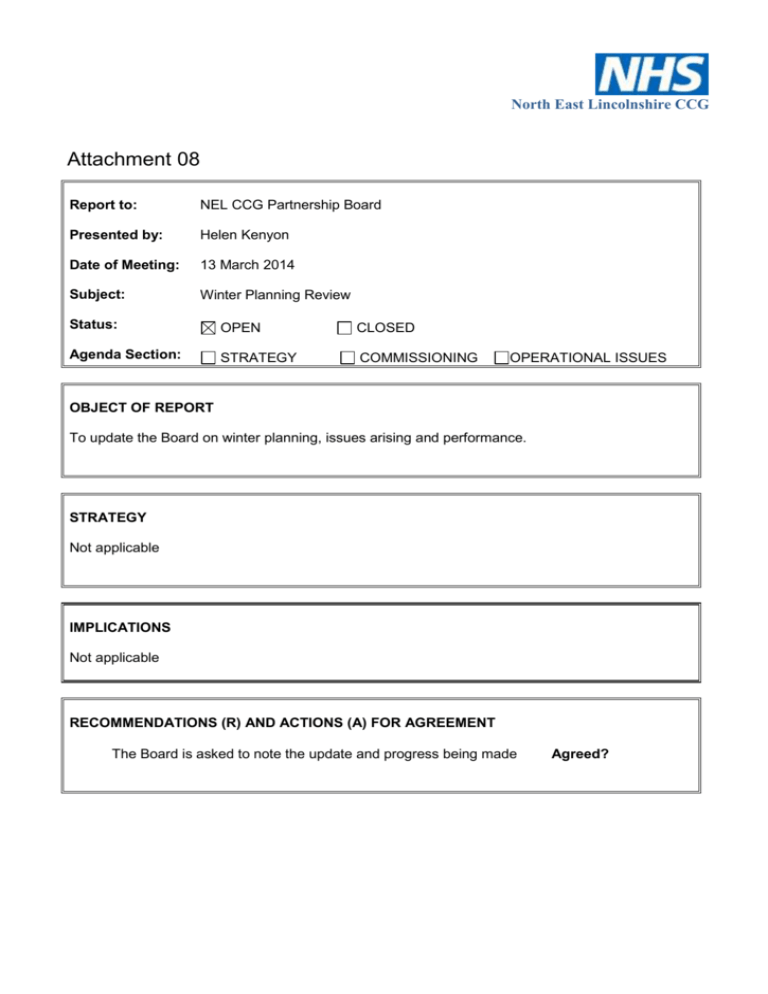
North East Lincolnshire CCG Attachment 08 Report to: NEL CCG Partnership Board Presented by: Helen Kenyon Date of Meeting: 13 March 2014 Subject: Winter Planning Review Status: OPEN CLOSED Agenda Section: STRATEGY COMMISSIONING OPERATIONAL ISSUES OBJECT OF REPORT To update the Board on winter planning, issues arising and performance. STRATEGY Not applicable IMPLICATIONS Not applicable RECOMMENDATIONS (R) AND ACTIONS (A) FOR AGREEMENT The Board is asked to note the update and progress being made Agreed? Yes/No Does the document take account of and meet the requirements of the following: i) Mental Capacity Act ii) CCG Equality Impact Assessment iii) Human Rights Act 1998 iv) Health and Safety at Work Act 1974 v) Freedom of Information Act 2000 / Data Protection Act 1998 iv) Does the report have regard of the principles and values of the NHS Constitution? www.dh.gov.uk/en/Publicationsandstatist ics/Publications/PublicationsPolicyAndG uidance/DH_113613 Comments NEL Winter Planning Update We are now more than 4 months into the 5 month “official winter” period covered by the intensive winter monitoring and reporting regime established under the NHS England framework. Established to support A&E 4 hr wait performance, this process necessarily takes a whole system view of demand, resources, bed capacity and discharge, i.e. the patient flow and establishes a wraparound scheme of risk assessment, monitoring and escalation. As February ends we have yet to see any significant ice or snow or some of the usual related winter patterns and consequently it has been a different winter activity pattern with notable activity levels in February continuing into March. This pattern seems common to SGH in North Lincs but not notably across the wider NY and Humber region which seems to have been more problematic for them compared to NEL/NL in the earlier winter months. In the period, the overall system has performed well. A&E 4 hr wait performance was compliant for Q3 ( Oct, Nov, Dec ) with Q4 to date (Jan and Feb) also currently compliant. This is an improvement on last year particularly through the Christmas and January holiday period. To date through this period there has been one significant event and this was a notable period of sustained activity at the end of February into early March where bed capacity became critical with a resultant impact on patient flow and A&E performance. This was not predicable and was marked enough to impact on normal recovery. Some of the planning aspects though to have contributed to performance are ( not exclusively ): Improved processes at DPoW to manage infection control outbreaks. Some sporadic closures of community facilities for D&V have not resulted in ward closures to date. This was identified as the highest risk based on the levels of ward closures seen last year and the resultant impact on patient flow and A & E performance. The extension of the GP in A&E service and use of step-up beds community capacity are both regarded as having supported A&E pressures by reducing the activity required to be dealt with by A&E. Both schemes need to continue and be extended and developed to continue to allow A&E to focus on specialist emergency care. The GP in A&E scheme is now well established and is dealing with ~ 20% of attendees during operating hours and supporting A&E performance in this way. The service has recently begun operating at weekends, integrated with the GP Out of Hours service, as part of the 7 day working developments. A&E staffing regime was improved with actions taken to ensure additional consultant and nurse cover where demand was predicted or over traditional holiday periods. Staffing remains an issue due to predicted difficulties with sickness, recruitment and bank availability and this will continue to be a focus for winter planning assurance from all providers. It is evident that the processes established for monitoring and escalation planning would serve us well (in some form) as a continuous around the year approach to monitoring with the core provider groups that can have an impact on patient flow. The single significant event so far this year came about, not through the most expected risks but by a sustained period of high attendee activity and within that a high level of admissions. These peaks occur regularly and occasionally, as in this case continue past the point where bed availability can be continually managed to ensure adequate supply. The most important lesson is that all parties need to improve the pro-active escalation of their activity to support the management of the pressure situation and whilst this already happens it is not formalised for community providers and they too act to their own resource capacity. This year, the development of the basis for a contractual, flexible alliance of providers that take more of the pressure in these circumstances should be a priority, along with the supportive enablers such as the SPA. Year to date - All Emergency Admissions Overall at month 10, emergency admissions are slightly below where the total was last year. A different winter pattern is being seen this year with activity higher in the latter months however A&E performance has been maintained. A&E 4hr wait performance DPoW A&E % discharged or admitted within 4 hrs JULY AUGUST SEPTEMBER OCTOBER NOVEMBER DECEMBER JANUARY FEBRUARY MARCH 12/13 13/14 96.4% 96.4% 96.2% 97.2% 96.5% 91.9% 92.7% 95.6% 93.9% 97.2% 96.1% 96% 96.8% 95.7% 94.9% 96.8% 95.9% - Impact of extending GP in A&E to 7 days Whilst not conclusive, the variation in weekend A&E performance appears to have been improved directly at the point of introduction of weekend operation of the GP in A&E ( Feb 2014 )






